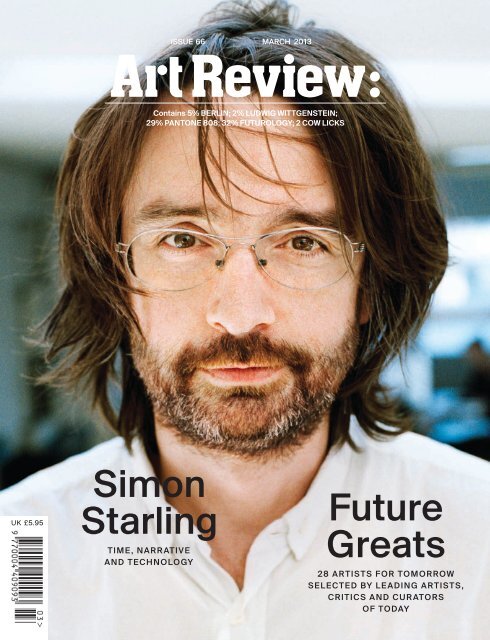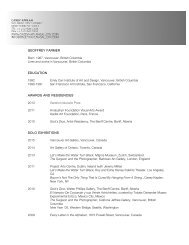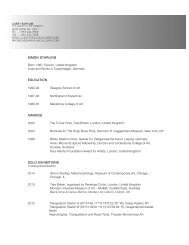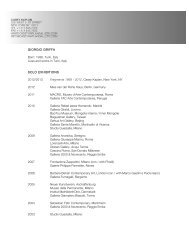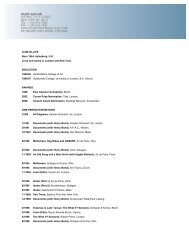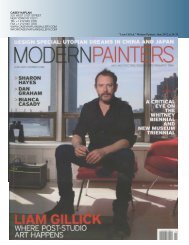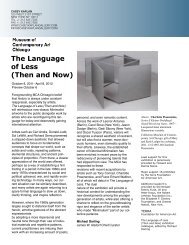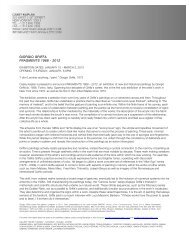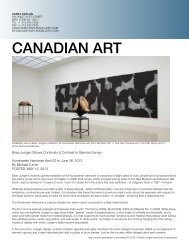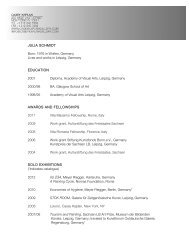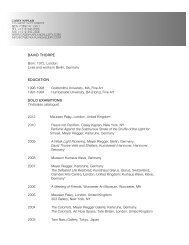Future Greats simon starling - Casey Kaplan
Future Greats simon starling - Casey Kaplan
Future Greats simon starling - Casey Kaplan
- No tags were found...
You also want an ePaper? Increase the reach of your titles
YUMPU automatically turns print PDFs into web optimized ePapers that Google loves.
this page:Project for a Masquerade(Hiroshima): The Mirror Room,2010 (installation view, theModern Institute/Toby WebsterLtd, Glasgow, 2010), 3 of 6wooden masks (carved by YasuoMiichi), 2 cast bronze masks,metal stands, bowler hat,suspended mirror, dimensionsvariable. Photo: Keith Hunter.Courtesy the artist and theModern Institute/Toby WebsterLtd, Glasgowfacing page:Shedboatshed (MobileArchitecture No 2), 2005,wooden shed, 390 x 600 x 340cm, production photos, RiverRhine, Switzerland. Photo: theartist. Courtesy the artist and theModern Institute/Toby WebsterLtd, Glasgowpreceding pages:Work, Made-Ready, KunsthalleBern: A Charles Eames‘Aluminum Group’ chair remadeusing the metal from a ‘MarinSausalito’ bicycle / A ‘MarinSausalito’ bicycle remade usingthe metal from a Charles Eames‘Aluminum Group’ Chair, 1997,bicycle, chair, 2 plinths, glass,vinyl text, dimensions variable(installation views, Glasgow,Kunsthalle Bern, 1997). Photo: theartist. Courtesy the artist and theModern Institute/Toby WebsterLtd, Glasgow72Simon Starling
on a networked, more human and less strictlyphilosophical or linguistic register. Yes, it can benerdily complex – and there’s a certain pleasureto be had in tracing that complexity – and it canbe just as absurdly simple (see the titles of themajority of Starling’s works). But most of all it’swork that chimes directly with our post-Internetworld, with its increasingly interwoven issues ofenvironment, ecology, capital and globalisation.Starling’s work uses objects to generatesprawling tales – often concerning thefabrication, display and dissemination of artobjects, woven together with their connectionsto the political, social and economic systemsthat more generally structure and locate theposition of objects within the world. An earlywork, A Charles Eames ‘Aluminum Group’ ChairRemade Using the Metal from a ‘Marin Sausalito’Bicycle / A ‘Marin Sausalito’ Bicycle RemadeUsing the Metal from a Charles Eames ‘AluminumGroup’ Chair (1997), features objects designedto hold stationary and moving bodies. The bike(exhibited leaning against a plinth) looks likea bike, and the chair (on a plinth) looks like achair. But we know, on some originary level,that the chair was once a bike and the bike wasonce a chair, and then start thinking about thesimilarities and differences between the pair ofCalifornia-designed objects. The objects becomesubjects – or at least the two categories becomeblurred. Quite literally in 5 Handmade Platinum/Palladium Prints of the Anglo American PlatinumMine at Potgieterus, South Africa, produced using asmany platinum group metal salts as can be producedSTARLIng’s artworksTEnd to opeRATe as boTHnarrativES andOBJECTS; start thinkingABout the boAT bit ofTHE shed’s past and youcease to be thinKIng ofits SHEDnESSfrom one ton of ore (2005), for which Starlingtravelled to platinum mines to make photographsof the mines using platinum from the mines.Project for a Masquerade (Hiroshima) (2010–11)is a more complex and recent work that spansa set of Japanese masks, nine characters (iconsof the Cold War), a film and a proposition for atheatrical performance. Like several of Starling’sworks, it also incorporates the story of an artwork– a Henry Moore sculpture that exists in differentforms and contexts (Nuclear Energy, 1967, a largepublic monument in Chicago, and a small bronzeedition, Atom Piece, 1964–5, acquired by theHiroshima Museum in 1987, shortly after Moore’sdeath, the first appearing to celebrate the dawnof the nuclear age, the second, to mourn it) – andthen poses questions regarding how we knowwhat this object is. ‘I like the idea that works don’tdie but keep being remade, reconstituted andretold in different ways,’ Starling said in a recentinterview with curator Francesco Manacorda.It’s tempting to think of Starling’s workas the product of a postquantum (and with this,particularly for an artist who grew up during thelast few decades of the Cold War, postnuclear)ArtReview 73
this page, clockwise from top left:Simon Starling’s studio, includingsign by building entrance; twoviews of Denis Diderot, A DiderotPictorial Encyclopedia of Tradesand Industry; drawing table withcatalogue from the Starlingcuratedexhibition Never theSame River (Possible <strong>Future</strong>s,Probable Pasts), 2010, CamdenArts Centre, London, a workingsketch for Starling’s Trois CentCinquante Kilogrammes parMètre Carré, KunsthalleMulhouse, 2012, 100 Chairs in100 Days in Its 100 Ways, 2007,by Martino Gamper, conical borerand reamer74Simon Starling
this page, from right:interior view of Starling’s studio,including, on the pinboard, aworking sketch for Tate BritainCommission: Simon Starling,2013, and the artist’s VenusMirror (05.06.2012), 2012;framed print from Illustrations forthe Moon: Considered as aPlanet, a World, and a Satellite,1874, by James Nasmyth andJames Carpenter, one of 25 printsexhibited in The InaccessiblePoem, 2011, Fondazione Merz,Turin, alongside work by Starlingand other artistsage, an age of uncertainty and instability. In1927 the German theoretical physicist WernerHeisenberg speculated that the more you knowabout the position of a particle, the less youknow about its momentum (and vice versa). Onecould see Starling proposing something similarwith regard to artworks. His artworks tend tooperate as both narratives (velocity) and objects(position); start thinking about the boat bit ofthe shed’s past and you cease to be thinking ofits shedness.The tricky thing, however, is judging towhat extent the objects Starling displays arecapable of divulging the narratives he conveys.Indeed many of his critics accuse him ofloading objects with more ideas than they cancommunicate without the help of lengthy andinvolved background stories or explanations.But like the horsebeef (to take a relatively crudeexample), this is the case with most objects inthe world, which are, in essence, accumulationsof data tracing their passage through space andthrough time. Some of this data is obvious in theobject, some of it isn’t.It’s a painfully cold January afternoonwhen I meet Simon Starling in Tate Britain’smembers’ room. He’s not allowed to discussthe specifics of why he is here. Not becausehe doesn’t want to, but because exhibitions inthese kinds of institutions need to be dramatic.It’s tempting to thinkof STARLIng’s workas the product of apoSTquantum age, an ageof unCERTAInTY andinSTABILITYSo no one can know the details until 12 March,when his instalment of Tate Britain’s annualcommission series opens to the public in theinstitution’s neoclassical Duveen Galleries.The official press release (which I’m handed)promises an installation that’s going to beambitious, new and site-specific. That’s the lot.It feels not a little ironic to be chatting aroundthis void of information, given the centrality ofdata to Starling’s work. Still, some of Starling’smost intriguing projects have tackled the historyand function of the art institution, the mostrecent example in London being Never the SameRiver (Possible <strong>Future</strong>s, Probable Pasts) (2010) atCamden Arts Centre, a show curated by Starlingthat featured 30 works by various artists installedin the exact positions they had been originallyexhibited over 50 years of Camden exhibitions.That show made the institution’s past presentand invited the visitor to think of the passageof artworks and institutions through time and,like many of Starling’s works, through changingcontexts. If his project for Tate is anything like asgood, it will be a show you won’t want to miss.Tate Britain Commission: Simon Starling ison view at Tate Britain, London, from 12 March to20 OctoberArtReview 75


